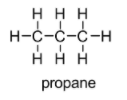
Define:
(a) Saturated hydrocarbon
(b) Unsaturated hydrocarbon
(c) Catenation
Answer
488.7k+ views
Hint: All the organic compounds possessing carbon as well as hydrogen atoms are known as hydrocarbons. These are naturally-occurring compounds and they generally form the basis of natural gas, crude oil, coal, and other energy sources.
Complete step by step answer:
Hydrocarbons are mainly classified as saturated hydrocarbons and unsaturated hydrocarbons.
(a) Saturated hydrocarbon: Saturated hydrocarbons are the simplest form of hydrocarbons consisting of only single bonded carbon atoms. They are known as saturated owing to the capacity of each carbon atom to form bonds with as many hydrogen atoms as possible. We can say that carbon atoms are saturated with the hydrogen atoms. Example: alkanes like methane, ethane, propane, etc.

(b) Unsaturated hydrocarbon: Unsaturated hydrocarbons belong to the class of hydrocarbons which possess either double or triple covalent bonds between the adjacent carbon atoms. The term "unsaturated" indicates that more hydrogen atoms can be appended into the hydrocarbon in order to make it saturated. Generally, an unsaturated hydrocarbon includes straight chains (alkenes and alkynes) and also branched chains or aromatic compounds. Examples: propene, propyne, cis-2-butene, cyclopentene etc.

(c) Catenation: Catenation refers to the process in which an element binds to itself via covalent bonds which leads to the formation of either chain or ring molecules. Carbon is the most common example of an element which exhibits catenation. Carbon can lead to the formation of long hydrocarbon chains as well as rings like benzene.

Note: If hydrocarbons enter the lungs, it usually causes pneumonia and even death. Some hydrocarbons can also cause coma, irregular heart rhythms, seizures, or damage to the liver or kidneys.
Complete step by step answer:
Hydrocarbons are mainly classified as saturated hydrocarbons and unsaturated hydrocarbons.
(a) Saturated hydrocarbon: Saturated hydrocarbons are the simplest form of hydrocarbons consisting of only single bonded carbon atoms. They are known as saturated owing to the capacity of each carbon atom to form bonds with as many hydrogen atoms as possible. We can say that carbon atoms are saturated with the hydrogen atoms. Example: alkanes like methane, ethane, propane, etc.

(b) Unsaturated hydrocarbon: Unsaturated hydrocarbons belong to the class of hydrocarbons which possess either double or triple covalent bonds between the adjacent carbon atoms. The term "unsaturated" indicates that more hydrogen atoms can be appended into the hydrocarbon in order to make it saturated. Generally, an unsaturated hydrocarbon includes straight chains (alkenes and alkynes) and also branched chains or aromatic compounds. Examples: propene, propyne, cis-2-butene, cyclopentene etc.

(c) Catenation: Catenation refers to the process in which an element binds to itself via covalent bonds which leads to the formation of either chain or ring molecules. Carbon is the most common example of an element which exhibits catenation. Carbon can lead to the formation of long hydrocarbon chains as well as rings like benzene.

Note: If hydrocarbons enter the lungs, it usually causes pneumonia and even death. Some hydrocarbons can also cause coma, irregular heart rhythms, seizures, or damage to the liver or kidneys.
Recently Updated Pages
Express the following as a fraction and simplify a class 7 maths CBSE

The length and width of a rectangle are in ratio of class 7 maths CBSE

The ratio of the income to the expenditure of a family class 7 maths CBSE

How do you write 025 million in scientific notatio class 7 maths CBSE

How do you convert 295 meters per second to kilometers class 7 maths CBSE

Write the following in Roman numerals 25819 class 7 maths CBSE

Trending doubts
State and prove Bernoullis theorem class 11 physics CBSE

What are Quantum numbers Explain the quantum number class 11 chemistry CBSE

Write the differences between monocot plants and dicot class 11 biology CBSE

1 ton equals to A 100 kg B 1000 kg C 10 kg D 10000 class 11 physics CBSE

State the laws of reflection of light

In northern hemisphere 21st March is called as A Vernal class 11 social science CBSE




